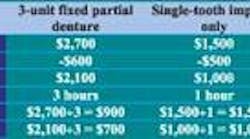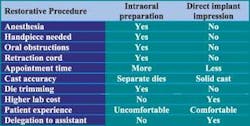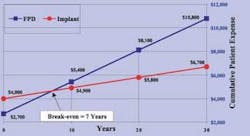George Priest, DMD, and ,br>Judy Priest, MBA
Dental implants will inevitably become the standard of care for replacement of a single-missing tooth, but most dentists do not perform this valuable service on a routine basis. In fact, fewer than 40 percent of general dentists perform even a single implant a year. Although most dentists believe that implants are successful procedures, two financial misconceptions are major obstacles to their use for single-tooth replacement.
1) Many dentists believe that implant dentistry is not profitable. This may be a result of inadequate training and experience with implants.
2) Many think patients missing a single tooth will be reluctant to accept the higher initial fee associated with an implant, compared with the lower fee for a traditional fixed partial denture.
In this article, we'll examine the potential profitability of single-tooth implant replacements for dentists and the financial value for patients. Published information addressing the financial impact of single implants is scarce. Most available studies provide an economic comparison between conventional removable prostheses and implant prostheses for edentulous patients or between fixed and removable prostheses for the same cohort.
To examine the financial impact of a single-tooth replacement using dental implants, it will be compared to the alternative of a fixed partial denture. Single-tooth implant replacements and three-unit fixed partial dentures will be analyzed in relation to fees, costs, productivity, profitability, and patient value over short-term and long-term perspectives. The purpose of this analysis is to illustrate that dental implants are favorable economic alternatives for both dentists and patients.
Dentist profitability
To evaluate the profitability of a single-tooth implant replacement, let's compare it with a three-unit, fixed- partial denture in terms of patient fees, laboratory and component costs, and productivity rate (See Figure 1). The fees, costs, and productivity assumptions presented in this article are generalized and may not be typical of a particular region. They are presented for illustrative purposes, but the comparisons presented are still applicable. The fee assumptions are based upon those found in the ADA's 2001 Survey of Dental Fees. They were then adjusted to reflect current-year figures.
Patient clinical fees
Many dentists are uncomfortable quoting higher combined surgical and restorative implant fees to their patients. A typical clinical fee for a single crown is $900, or $2,700 for a three-unit fixed partial denture. Alternatively, the implant restoration fee is $1,500, including a crown fee of $900 and a custom abutment fee, if required, of $600. Patient fees for an interim prosthesis for a single implant add roughly $400 to the cost. That makes the total initial restorative fee for a single implant approximately $1,900.
For a patient to adequately compare the two alternative-treatment plans, the single implant restoration fee should include an estimate for a surgical guide and surgical implant placement. Restorative dentists must use caution when quoting surgical fees. You might suggest an approximate surgical fee, but it is more appropriate to refer the patient to the treating surgeon for an accurate fee estimate.
Based on a typical surgical fee of $1,800 and a surgical guide fee of $300 for the placement of a single implant, the combined surgical and restorative clinical fees for a single-tooth implant is approximately $4,000. The fee might be lower if a surgical guide or interim prosthesis are unnecessary, or it might be higher if hard- or soft-grafting procedures are warranted.
Laboratory and component costs
Many dentists also are reluctant to select the implant option because of higher laboratory and component costs. The total laboratory cost for a three-unit fixed partial denture is $600, based on a generalized fee of $200 per unit. The total laboratory cost for a single-implant crown with a custom-milled abutment is slightly less at $500. If an interim removable partial denture is necessary for the implant replacement, an additional $150 laboratory fee applies for a total of $650. The total laboratory and component cost of this one implant crown alone deters some dentists from offering this state-of-the-art service to their patients.
Productivity
Productivity is a measurement of efficiency defined as the net fees (patient fees less laboratory and component costs) generated per hour of appointment time. Dentists comparing the initial cost of a three-unit, fixed-partial denture with that of a single-implant crown might mistakenly conclude that the three-unit fixed partial denture is more profitable. However, this erroneous conclusion ignores productivity — the most significant factor affecting profitability. A dentist's use of time is a greater cost factor than any product, system, or procedure. Minimizing appointment time is key to achieving efficiency and increasing profitability.
A three-unit fixed partial denture, with no complications, generally requires two appointments totaling three hours of treatment time. The first appointment involves anesthesia, tooth preparation, shade selection, impressions, provisional-restoration fabrication, and jaw-relation records. It usually runs about two and a half hours. Seating a three-unit fixed partial denture requires an occlusal correction on nearly an entire quadrant. As a result, an additional half hour must be factored into the second appointment so that occlusion and proximal contacts can be refined, pontic surfaces can be modified, and the prosthesis can be cemented.
By dividing the clinical fee of $2,700 by three hours of treatment time, the dentist's production rate for a three-unit, fixed-partial denture is $900 an hour, or $700 per hour net of laboratory costs.
The key to efficient implant restorative protocol is the use of systems and components designed exclusively for implant dentistry and effective delegation to staff and laboratory. To maximize efficiency, most implant- restorative procedures should be performed extraorally. Reducing intraoral procedures is more efficient, patient-friendly, and ultimately more profitable than the anachronistic concept of conventional procedures marketed by many dental implant companies. (See Figure 2.)
Making impressions directly to the implant virtually eliminates anesthesia, abutment preparation, tissue retraction, and searching for illusive margins required with traditional fixed prostheses. Additionally, extraoral- abutment preparation reduces encumbrances by intraoral structures and patient discomfort. Many procedures related to impression-making can be delegated to the dental assistant. A healing abutment is removed, an atraumatic implant-level impression quickly and accurately records implant location, and the healing abutment is then replaced. Abutment preparation is delegated to the laboratory technician, who can prepare it much more efficiently than a dentist relying on intraoral techniques. A laboratory technician's fee for this service is substantially less than the typical revenue generated by a dentist for the same amount of production time.
Based on the implant protocol outlined above, the single-tooth implant restoration requires two restorative appointments just as the fixed partial denture does, but the total treatment time is reduced to one hour or less. During the first appointment, impressions, shade selection, and jaw-relation records are completed in a half hour. The added stability of unprepared adjacent teeth makes registration of jaw-relation records less time-consuming than that of a traditional fixed partial denture. During the second appointment, also completed in a half hour, the abutment is seated and tightened to specified torque, and proximal and occlusal contact areas are refined. Few adjustments are necessary when using the machined implant components and solid casts designed specifically for implant dentistry. If an interim prosthesis is necessary, an additional half-hour appointment is required prior to the restorative phase of treatment.
Doing the math
The restorative dentist's profitability for a single-implant restoration is similarly calculated by including clinical fees, laboratory and component costs, and productivity (Figure 1). Based on the total restorative appointment time of one hour, the dentist's production rate for a single implant restoration is $1,500 per hour or $1,000 per hour less laboratory and component costs. This net production rate of $1,000 per hour for the single-implant restoration is $300 per hour more profitable than the three-unit fixed partial denture. If an interim prosthesis is required, the dentist's net production rate still would be $833 per hour after including the additional laboratory cost of $150.
The implant alternative becomes even more profitable if practice-overhead costs are included. The hourly overhead costs associated with the single- implant would be less than half that of the fixed partial denture (one and one-half hours vs. three hours respectively). Because hourly overhead rates vary widely between practices, specific overhead assumptions are not included in this analysis. With or without the inclusion of overhead costs, the single implant prosthesis might be the most profitable procedure restorative dentists can perform.
Patient value
The single implant is clearly more profitable for dentists than the three-unit fixed partial denture. However, is the single implant the more cost-effective alternative for the patient? For purposes of this article, long-term cumulative costs will be used to measure patient value. The alternative with the lower, long-term cumulative cost provides the patient with higher value. Both initial and long-term costs of replacement are used to calculate the cumulative costs of the alternatives over 30 years. (See Figure 3.)
A break-even analysis is performed to determine the point in time in which the single implant option becomes economically advantageous for patients. Several assumptions are required to complete this comparison:
1) The average life span for both prostheses is 10 years, based on available published data on longevity of the two treatment alternatives.
2) Respective increases in patient fees for the two alternatives over time will grow at the same rate, thereby justifying a "current-dollars approach."
3) Abutment teeth supporting fixed partial dentures remain intact.
4) The single implant remains successfully integrated.
5) No biological complications occur throughout the life span of either prosthesis.
6) The patient fees, laboratory and component costs, and productivity assumptions from the previous section still apply.
7) The initial or ongoing costs for either restoration may be lower or higher depending upon the actual treatment plan.
8) Potential insurance benefits are not included in this analysis.
The expected longevity of both treatment modalities is a critical component in the calculation of cumulative lifetime costs. The few studies documenting the longevity of conventional fixed partial dentures present varied criteria of success and failure, and they are not specific for single-tooth replacements. Thus, meaningful comparisons between these studies are difficult to make. Those studies that have examined longevity report expected life spans from 6.3 to 20 years. Several investigators have noted that failure rates appear to increase abruptly after approximately 10 years. Recurrent caries and tooth fracture are reported to be major reasons for replacement. A young patient replacing a single missing tooth is likely to receive three or more prostheses over a lifetime. Successive prostheses may inflict further biologic complications, including tooth fracture, recurrent caries, periodontal pathology, endodontic intervention, and even additional tooth loss. These sequelae translate into larger prostheses and higher long-term biological and financial costs. So, for purposes of this cost analysis, a life span of 10 years will be used for a fixed partial denture replacing a single missing tooth.
Success rates for single-tooth implants compare favorably with other tooth-replacement procedures. In contrast to research examining fixed partial dentures, strict parameters of success have been established for dental implants. Data from 5 to 15 years demonstrate success rates from 88 percent to 100 percent for single-tooth implants, with expected lifetime success rates approaching 97 percent. Prosthetic failures are relatively rare on single-tooth implant replacements. The risk of crown failure from the lack of implant integration is low, because most implant failures occur early, before prosthetic implant treatment begins. The most common complication concerning single implants has been screw-loosening, usually related to earlier types of abutments, with actual abutment failure rarely reported. Many of the causes of prosthesis replacement on natural teeth — including tooth fracture, caries, periodontal disease, and endodontic therapy — are not relevant to implants. For these reasons, crown longevity of single implants should be at least as favorable as that of conventional fixed partial dentures. Based on the above data, a 10-year implant crown-replacement cycle is a conservative assumption for this analysis.
Initial and long-term costs
Referring to the generalized fees presented above, a patient's total initial financial outlay for a single implant is approximately $1,300 more than for a fixed partial denture, based on an initial cost outlay of $4,000 and $2,700, respectively. However, if patients consider long-term cumulative costs, the single-implant alternative is the more cost-effective treatment and becomes increasingly advantageous over longer periods of time.
For a patient 20 years of age who loses a single tooth in a traumatic accident and selects a fixed partial denture, the total patient fee will double from $2,700 to $5,400 in 10 years. In 20 years, the cumulative fee increases to $8,100 and in 30 years, the fee escalates to $10,800. Over 30 years, the patient will have paid for 12 units of fixed prosthetic dentistry to replace a single missing tooth.
For the same hypothetical 20-year-old patient who selects the single implant, the total initial fee is $4,000. At 10 years, the cost of replacing the implant crown is $900 for a cumulative patient fee of $4,900. After 20 years, the cumulative patient fee increases to $5,800, and in 30 years, to $6,700. In the unlikely event that the implant abutment requires replacement, the patient fee would increase by an additional $600.
The economic break-even point occurs at the time when the patient fees of the two treatment options are equal (i.e., the intersection of the cumulative cost lines). Based on the cost assumptions in this analysis, the break-even point between the fixed partial denture and the single-tooth implant alternative is approximately seven years (Figure 3). The single-tooth implant option becomes more economically desirable at the time of the first prosthesis replacement. Furthermore, because of the greater likelihood of biologic complications associated with the fixed-partial denture, patients may have even higher ongoing costs than indicated here.
How can dentists use this analysis to present the value of single-implant restorations to patients? Any patient expecting to survive another seven years would benefit economically from an implant prosthesis. Because the average life span for a child born in the United States today is 77 years (males 74; females 79), age would rarely be a limiting factor in selecting an implant to replace a single missing tooth.
Beyond the break-even point of seven years, the economic advantage of a single implant prosthesis becomes even more compelling, particularly if the additional fees associated with the treatment of biologic complications of a fixed partial denture are considered. At 30 years out, without complications, the cumulative patient fees for maintaining a fixed partial denture are approximately 61 percent greater than those of the singleimplant alternative.
Long-term economic winner
Conventional philosophy has prevented many dentists from grasping the economic benefits of single-tooth implant restorations. The results of this analysis should help dispel the financial misconceptions that have been barriers to considering implants as replacements for single missing teeth. Compared with the fixed partial denture, the single-implant option is the more profitable procedure for dentists and provides greater economic value for their patients.
Dentists can realize higher productivity rates and greater profits by using efficient implant restorative techniques for single-implant restorations. These techniques rely on direct-implant impressions which minimize intraoral procedures and maximize efficiency. Emerging technology for simplified impressions and CAD-CAM systems for creating custom implant abutments will further distance dentists from conventional protocols and make implant dentistry even more efficient. Although initial patient fees are higher for single-tooth implant replacements, long-term replacement expenditures are significantly less. All this adds up to making the implant the better economic alternative at the first prosthesis replacement.
Editor's Note: References for this article are available by request by emailing Dr. Priest at [email protected]. References also will be included with the online version of this article on Dental Economics' Web site at www.dentaleconomics.com.








